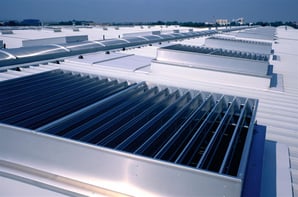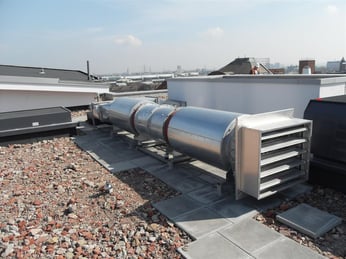Smoke extraction systems play a crucial role in ensuring the safety of buildings.
In the event of a fire, smoke can rapidly spread, making it difficult for occupants to evacuate and for firefighters to enter the premises. This is where smoke extract systems come into play, as they are designed to remove smoke and heat from buildings, allowing for the safe evacuation of occupants and providing easier access for emergency responders.
In this article, we will delve into the fundamentals of smoke extraction systems, discussing their importance, requirements, components, design considerations, types, installation, maintenance, and the benefits they bring to modern buildings.
The Importance of Smoke Extraction in Buildings
The importance of smoke ventilation systems in building safety cannot be overstated. In the unfortunate event of a fire, smoke can spread rapidly, obscuring vision, causing respiratory problems, and creating panic among occupants. A properly designed and maintained smoke extraction system can significantly reduce the risks associated with fire incidents. By promptly removing smoke from the affected area, these systems create a clear pathway for evacuation, preventing the inhalation of toxic fumes and reducing the chances of injuries or fatalities. Additionally, smoke extraction systems aid firefighters in their efforts to locate and control the fire source, enabling them to respond more effectively and minimise property damage.
Understanding Smoke Control System Requirements
To ensure the effectiveness of a smoke control system, it is crucial to understand the specific requirements of the building in question. Each building has unique characteristics that need to be considered during the design and installation of the system. Factors such as building layout, occupancy type, fire protection measures, and local building codes must all be taken into account. The smoke extraction system should be designed to accommodate the maximum potential fire scenario and provide sufficient airflow to extract smoke and heat quickly. It is also essential to consider the location of smoke vents to optimise smoke removal and avoid recirculation. Regular testing and maintenance are necessary to ensure that the system continues to meet the building's requirements and remains in compliance with safety regulations.
Components of a Smoke Extraction System
A smoke vent system consists of several key components that work together to effectively remove smoke and heat from the building. These components include smoke exhaust fans, smoke ventilators, smoke detectors, controls, and power supplies. Smoke exhaust fans are responsible for creating the necessary airflow to extract smoke, while smoke vents provide the openings through which the smoke is released through its own natural buoyancy. Smoke detectors are essential in detecting the presence of smoke and activating the system. Controls play a vital role in monitoring and coordinating the operation of the system, ensuring that it activates when needed. Finally, a reliable power supply and a back up is critical to ensure the continuous functioning of the system during a fire emergency.
Design Considerations for Smoke Ventilation Systems
Designing a smoke extraction system requires careful consideration of various factors to ensure its effectiveness and compliance with safety regulations. The design process should begin by conducting a thorough assessment of the building's layout, identifying areas of high risk, areas that need protecting and potential smoke accumulation. The system design should incorporate the appropriate number and size of smoke extraction vents to facilitate efficient smoke removal. The positioning of smoke detectors should be strategically planned to ensure early detection and activation of the system. Additionally, the system should be designed to operate independently of other building services to ensure its availability during power outages or system failures. Collaborating with experienced fire safety engineers and experts such as Colt who use state-of-the-art modeling and simulation tools can greatly assist in the design process, resulting in an optimised smoke extraction system.
Types of Smoke Extraction Systems for Buildings
There are various types of smoke extraction systems available for buildings, each suited to different applications and building configurations. The most common types include natural smoke extraction systems, mechanical smoke extraction systems, and hybrid smoke extraction systems. Natural smoke extraction systems utilize natural ventilation principles, relying on the buoyancy of hot smoke to rise and escape through roof openings. Mechanical smoke extraction systems, on the other hand, employ fans to induce airflow and extract smoke from the building. Hybrid smoke extraction systems combine elements of both natural and mechanical systems, offering flexibility and efficiency in smoke removal. The selection of the most suitable system type depends on factors such as building design, occupancy type, fire protection measures, and budget constraints. In certain instances, pressurization systems might be the best option. To learn more about what pressurization is and when it is best used, read our blog.
In conclusion, smoke extraction systems are vital components of modern building safety measures. They play a crucial role in evacuating occupants safely during fire incidents and aiding firefighters in their response efforts. Understanding the requirements and components of these systems is essential for their effective design, installation, and maintenance. By selecting the appropriate system type and adhering to industry best practices, building owners can enhance the safety of their premises and minimise the potential risks associated with fires. Implementing smoke extraction systems not only protects lives but also preserves property, reduces insurance costs, and fosters a sense of security among building occupants.
Expert training and advice
If you would like to learn more about the fundamentals of smoke control in buildings, ask us about hosting our 'Fundamentals of smoke control' CPD session at your offices. This informative presentation is CIBSE-accredited and will count towards your CPD points allowance.
To discuss your project requirements and consult our team of experts, please contact project.admin@uk.coltgroup.com.
